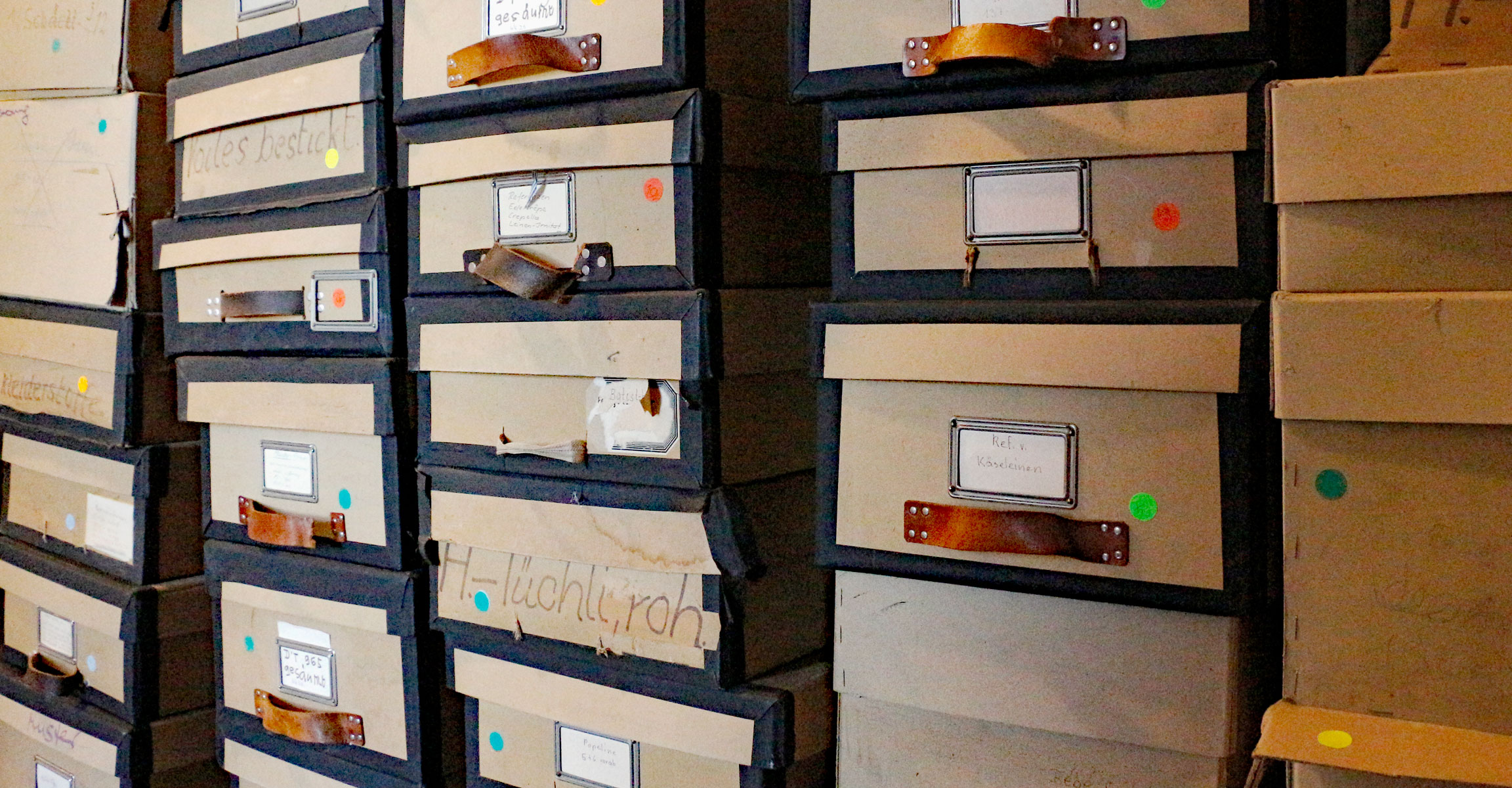Projects
The Textile Museum participates in national and international research projects dealing with questions of textile history, social and industrial history. The museum also initiates archiving and inventory projects and regularly publishes specialist publications. We thank our partners and sponsors who support us in our scientific work.
Securing and integrating the Schläpfer collection
The Lisbet and Robert Schläpfer Foundation donated its entire holdings to the Textile Museum St.Gallen in summer of 2021. The Schläpfer Collection includes thousands of fabric samples from the production from 1962 to 1995, e.g. clothes, photographs and numerous documents. By taking over the Schläpfer collection, the Textile Museum St.Gallen is able to secure an important part of St.Gallen’s industrial and fashion history. Jakob Schlaepfer AG was and is known for innovative and extraordinary designs that had a lasting impact on fashion.
The objects of the Schläpfer collection will be put into long-term archiving by the Textile Museum St.Gallen. They will be cleaned, documented, catalogued and professionally stored.
The company Jakob Schlaepfer AG dates back to an embroidery company founded in 1904. Jakob Schläpfer joined the company in 1908 and took over the business in 1934. After Jakob Schläpfer’s death in 1962, his son Robert and his wife Lisbet took over the business. In 1995 Jakob Schlaepfer AG was sold to the investors Meis and Bolte. In 1997, the company was sold on to Filtex AG and finally in 2016 to Forster Rohner AG in St.Gallen, which continues to run Jakob Schlaepfer AG as an independent division.
We would like to thank
Lisbet und Robert Schläpfer-Stiftung
![]()
![]()
Inventorisation of historic fabrics
The collection of historic fabrics at the St.Gallen Textile Museum consists of approx. 3,500 samples of valuable patterns from the Middle Ages to the mid-20th century. The Museum pursued the build-up of the fabric collection systematically from the very beginning and acquired both historic and contemporary pattern samples. In 1883, it purchased a large batch of various historic fabrics owned by Friedrich Fischbach. Just under 20 years later, Leopold Iklé donated further samples to the Museum. The acquisitions of the collections of John Jacoby (1954) and Charlotte Bing-Hübner (1976) round off the inventory. Another significant addition was the donation of the corporate collection of Grauer Frey in 1983. Ten years later, the Swiss Textile Colledge (STF) donated the 1,800 objects of the study collection of Zurich’s Silk Weaving College to the St.Gallen Textile Museum.
The project aims to record all the fabrics in digital form and to put all the information about them in a database between summer 2016 and autumn 2018. A representative selection will be posted in the online catalogue on the Museum’s website, and the collection of the Silk Weaving College will additionally be stored in the database of the Silk Memory Project of the Lucerne University of Applied Sciences and Arts / Textile Design. The project was made possible by support from the Zurich Silk Industry Society, the Metrohm Foundation, the Steinegg Foundation, the Vontobel Foundation and the Hans and Wilma Stutz Foundation.
Inventarisation of historic lace
The collection of historic lace at the St.Gallen Textile Museum is among the world’s most significant. It consists of about 6,500 samples. Top-class exhibits represent the most important centres of European lace production such as Italy, the Netherlands, Belgium, Germany and France.
The collection covers all the techniques of hand-made lace from the 16th to the 20th centuries and provides a representative overview of the history of lace production. However, its significance also resides in the fact that it served as a template for the machine embroidery marketed as “St.Gallen lace” at the time around 1900. The triumph of East Switzerland’s textile industry would not have been possible without these patterns since “St.Gallen lace” partially consisted of faithful copies of historic lace produced on shuttle embroidery machines.
The lace samples originated from corporate archives such as those of Isidor Grauer Frey, Otto Alder, Leopold Iklé and John Jacoby. In 1976, the Museum acquired the collection of the German-Swiss textile expert Charlotte Bing-Hübner, and Carolina Maraini-Sommaruga’s collection has been in the St.Gallen Textile Museum on permanent loan from the Swiss Confederation since 1963.
The aim is to record all the lace samples in digital form and to put all the information about them in a database between summer 2016 and autumn 2018. A representative selection will be posted in the online catalogue on the Museum’s website. In 2018, the results of the project will be presented in an exhibition.
The project is conducted with support from the Eastern Swiss Embroidery College Foundation, the Iklé Frischknecht Foundation and the Culture Promotion Office of the Canton of St.Gallen.






